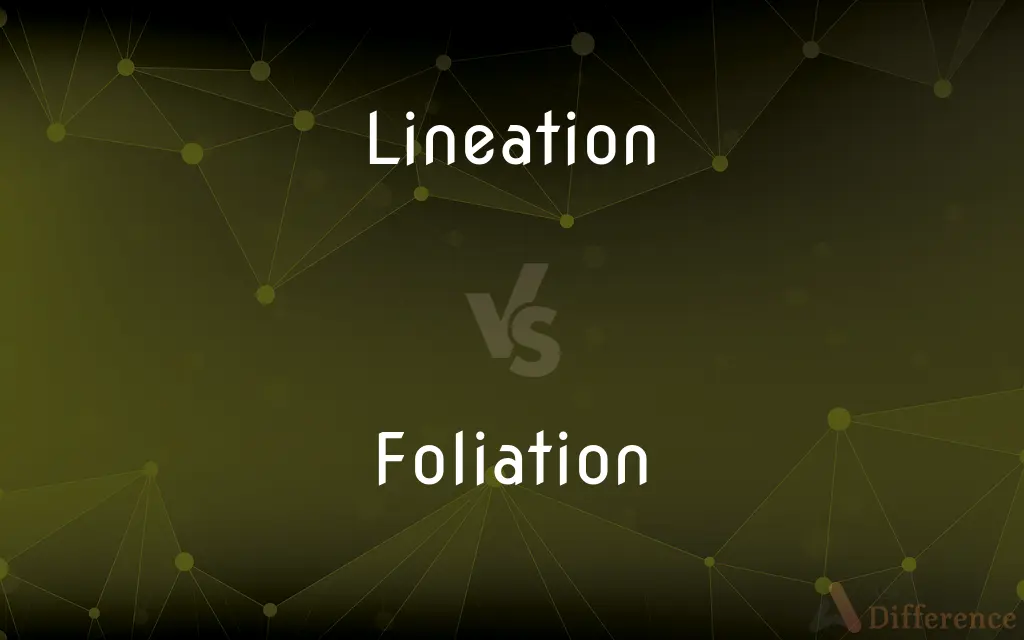Lineation vs. Foliation — What's the Difference?
By Fiza Rafique & Urooj Arif — Updated on April 8, 2024
Lineation refers to linear features within rock, often due to mineral alignment, while foliation involves the planar arrangement of mineral grains or structures in metamorphic rock.

Difference Between Lineation and Foliation
Table of Contents
ADVERTISEMENT
Key Differences
Lineation in geology indicates the presence of linear features within a rock, which can result from various processes, including the alignment of minerals due to deformation. These features provide insight into the deformation history and stress conditions of the rock. On the other hand, foliation refers to the parallel arrangement of mineral grains or structural features within metamorphic rock, often resulting from high pressure and temperature conditions that reorient minerals into layers or bands.
Lineation can be observed in both igneous and metamorphic rocks, manifesting as elongated structures like stretched pebbles or aligned minerals. This linear arrangement is typically perpendicular to the direction of compressional forces. Conversely, foliation is characteristic of metamorphic rocks, where it signifies the planar distribution of mineral grains, giving the rock a layered appearance. This planar structure is also perpendicular to the main compressive stress.
The development of lineation often accompanies the geological processes that lead to foliation, but the two can exist independently. Lineation is particularly useful in determining the flow direction of the rock during its formation or the direction of applied stress. Foliation, however, primarily indicates the conditions of pressure and temperature during metamorphism, revealing the rock's transformation history.
Geologists study lineations to understand the directional properties and deformation mechanisms within rocks, such as the orientation of tectonic stress fields. Foliation studies, however, focus on the metamorphic history and conditions that led to the rock's current structure, aiding in understanding the geological environment during rock formation.
While both lineation and foliation are integral to interpreting rock deformation and history, they highlight different aspects of geological processes. Lineation emphasizes the directional flow or stress conditions, whereas foliation showcases the metamorphic conditions and structural layering within the rock.
ADVERTISEMENT
Comparison Chart
Definition
Linear features within a rock.
Planar arrangement of mineral grains in metamorphic rock.
Occurrence
Igneous and metamorphic rocks.
Primarily in metamorphic rocks.
Indicates
Direction of flow or applied stress.
Conditions of pressure and temperature during metamorphism.
Manifestation
As elongated minerals or structures.
As layered or banded structures.
Geological Insight
Directional properties and deformation mechanisms.
Metamorphic history and conditions.
Compare with Definitions
Lineation
Results from mineral alignment.
The quartz minerals showed lineation, aligning perpendicularly to compression.
Foliation
Layered arrangement in metamorphic rocks.
The slate showed distinct foliation, with layers easy to split.
Lineation
Observed in various rock types.
Metamorphic rocks near the fault line displayed prominent lineation.
Foliation
Results from high pressure and temperature.
Foliation in the gneiss formed under intense metamorphic conditions.
Lineation
Linear features in rocks.
Lineation observed in the granite indicated past directional pressures.
Foliation
Indicates metamorphic conditions.
The degree of foliation reflects the intensity of the rock's transformation.
Lineation
Useful in understanding deformation.
Geologists analyze lineation to interpret the rock's stress history.
Foliation
Characteristic of metamorphic rocks.
Schist, known for its foliation, gleamed with mica layers.
Lineation
Can indicate flow direction.
Lineations in the volcanic rock trace the lava's flow path.
Foliation
Helps in determining rock formation environment.
Studying foliation patterns helps geologists understand past geological environments.
Lineation
The act of marking or outlining with lines.
Foliation
In mathematics (differential geometry), a foliation is an equivalence relation on an n-manifold, the equivalence classes being connected, injectively immersed submanifolds, all of the same dimension p, modeled on the decomposition of the real coordinate space Rn into the cosets x + Rp of the standardly embedded subspace Rp. The equivalence classes are called the leaves of the foliation.
Lineation
An outline.
Foliation
The state of being in leaf.
Lineation
An arrangement of lines.
Foliation
Decoration with sculpted or painted foliage.
Lineation
(geology) A linear feature in rock, often structural
Magnetic lineations
Foliation
(Architecture) Decoration of an opening with cusps and foils, as in Gothic tracery.
Lineation
(literature) The way in which line breaks are inserted in a poem
Foliation
The act, process, or product of forming metal into thin leaf or foil.
Lineation
Delineation; a line or lines.
Foliation
The act or process of coating glass with metal foil.
Lineation
The line that appears to bound an object
Foliation
The process of numbering consecutively the leaves of a book or manuscript.
Lineation
The act of marking or outlining with lines
Foliation
The leaves so numbered.
Foliation
(Geology) The set of layers visible in many metamorphic rocks as a result of the flattening and stretching of mineral grains during metamorphism.
Foliation
(botany) The process of forming into a leaf or leaves.
Foliation
(publishing) The process of forming into pages; pagination.
Foliation
The numbering of the folios of a manuscript or a book.
Foliation
(botany) The manner in which the young leaves are disposed within the bud.
Foliation
The act of beating a metal into a thin plate, leaf, foil, or lamina.
Foliation
The act of coating with an amalgam of tin foil and quicksilver, as in making looking-glasses.
Foliation
The enrichment of an opening by means of foils, arranged in trefoils, quatrefoils, etc.; also, one of the ornaments.
Foliation
(geology) The property, possessed by some crystalline rocks, of being divided into plates or layers, due to the cleavage structure of one of the constituents, as mica or hornblende. It may sometimes include slaty structure or cleavage, though the latter is usually independent of any mineral constituent, and transverse to the bedding, it having been produced by pressure.
Foliation
(topology) A set of submanifolds of a given manifold, each of which is of lower dimension than it, but which, taken together, are coextensive with it.
Foliation
The process of forming into a leaf or leaves.
Foliation
The manner in which the young leaves are dispo ed within the bud.
The . . . foliation must be in relation to the stem.
Foliation
The act of beating a metal into a thin plate, leaf, foil, or lamina.
Foliation
The act of coating with an amalgam of tin foil and quicksilver, as in making looking-glasses.
Foliation
The enrichment of an opening by means of foils, arranged in trefoils, quatrefoils, etc.; also, one of the ornaments. See Tracery.
Foliation
The property, possessed by some crystalline rocks, of dividing into plates or slabs, which is due to the cleavage structure of one of the constituents, as mica or hornblende. It may sometimes include slaty structure or cleavage, though the latter is usually independent of any mineral constituent, and transverse to the bedding, it having been produced by pressure.
Foliation
(botany) the process of forming leaves
Foliation
(geology) the arrangement of leaflike layers in a rock
Foliation
(architecture) leaf-like architectural ornament
Foliation
The production of foil by cutting or beating metal into thin leaves
Foliation
The work of coating glass with metal foil
Common Curiosities
How does foliation differ in appearance from lineation?
Foliation is characterized by a planar, layered structure within the rock, while lineation manifests as linear features or alignments.
What is lineation in geology?
Lineation refers to the linear arrangement or features within a rock, often resulting from mineral alignment due to deformation.
Can lineation and foliation occur together?
Yes, in metamorphic rocks, lineation and foliation can coexist, both resulting from deformation under different conditions.
How does foliation form in rocks?
Foliation forms under high pressure and temperature conditions during metamorphism, causing mineral grains to reorient into parallel layers.
Why is foliation common in metamorphic rocks?
Foliation is common in metamorphic rocks due to the directional pressures and temperatures that reorient minerals during metamorphism.
Can igneous rocks show foliation?
Foliation is primarily a feature of metamorphic rocks, though some igneous processes can produce planar structures, they are not typically referred to as foliation.
What geological processes lead to lineation?
Geological processes such as deformation, flow, and the alignment of minerals under stress can lead to lineation.
Are lineation and foliation indicators of specific geological environments?
Yes, they can indicate specific deformation environments, with lineation pointing to directional stresses and foliation to high-pressure metamorphic conditions.
Is lineation always visible to the naked eye?
Not always; some lineations require microscopic examination to be observed, depending on the scale and mineral size.
What does lineation tell us about rock history?
Lineation provides insights into the directional forces or stresses that acted on the rock, indicating its deformation history.
How does the scale of observation affect the identification of foliation?
The scale can affect identification, as some foliations are visible at hand specimen scale, while others require thin section microscopy.
What role does fluid play in the development of foliation?
Fluids can facilitate mineral reorientation and growth during metamorphism, contributing to the development of foliation.
How do geologists use lineation and foliation in their studies?
Geologists use these features to interpret the deformation history, stress conditions, and metamorphic environment of rocks.
What tools are used to study lineation and foliation?
Geologists use tools like compasses for measuring orientations, microscopes for examining textures, and software for analyzing spatial data.
Can the presence of foliation affect the rock's physical properties?
Yes, foliation can affect a rock's strength, permeability, and weathering patterns due to its layered structure.
Share Your Discovery

Previous Comparison
Dubstep vs. Dub
Next Comparison
Dealer vs. AgentAuthor Spotlight
Written by
Fiza RafiqueFiza Rafique is a skilled content writer at AskDifference.com, where she meticulously refines and enhances written pieces. Drawing from her vast editorial expertise, Fiza ensures clarity, accuracy, and precision in every article. Passionate about language, she continually seeks to elevate the quality of content for readers worldwide.
Co-written by
Urooj ArifUrooj is a skilled content writer at Ask Difference, known for her exceptional ability to simplify complex topics into engaging and informative content. With a passion for research and a flair for clear, concise writing, she consistently delivers articles that resonate with our diverse audience.















































